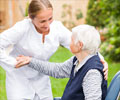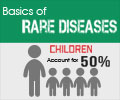Symptoms, Signs and Complications
Children with progeria appear quite normal at birth. The earliest signs of progeria are scleroderma -like symptoms which manifest as changes on the skin. Within a year to two of birth, other physical changes associated with premature aging slowly becomes more evident.
In Progeria-affected children growth is stunted--a ten year old would have the height of a three year old child.
Their bodies are extremely fragile, like the very old,and this is because these children age at a rate that is seven times faster than that of normal children. Is it of any wonder then, that a child of ten years would give stiff competition to his seventy year old grandfather? Now the sad saga does not end with just the looks; these hapless children suffer from all the ailments of the aged and are likely to die either of heart disease, stroke or heart attack, even while in their early teens.
Another salient feature is the striking resemblance among the affected individuals despite the differences in race or ethnicity.
Some of the prominent symptoms and signs of progeria are listed as follows:-
- Dwarfism / limited growth
- Alopecia or baldness
- Small face and a pinched nose
- Small jaw in comparison to head size
- Delayed tooth development
- Aged-looking, wrinkled skin
- Loss of eyebrows / hair
- Stiff joints / limited range of motion
- Frequent hip dislocations
- Premature arteriosclerosis
- Cardiovascular problems
- No sexual maturation
Amidst all this chaos there are, apparently, some features that remain normal in the Progeria victims. The most important feature is their normal mental growth which remains on par with children their age.
Progeria–affected individuals are also spared the trauma of certain age-related conditions, particularly those associated with wear and tear, such as cataract or osteoarthritis.









